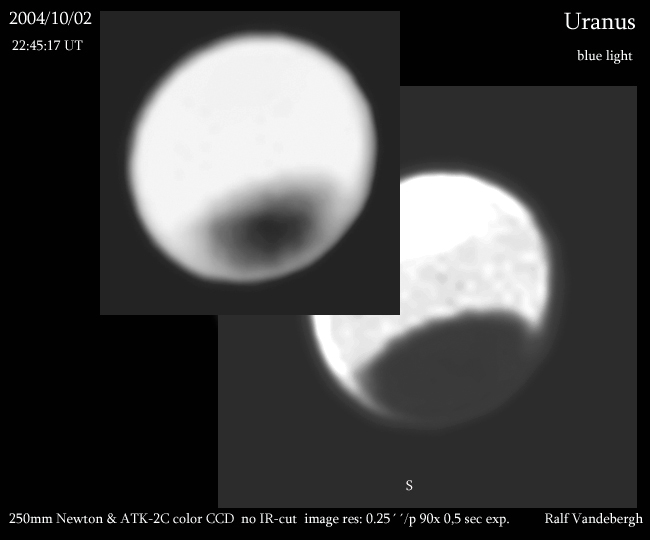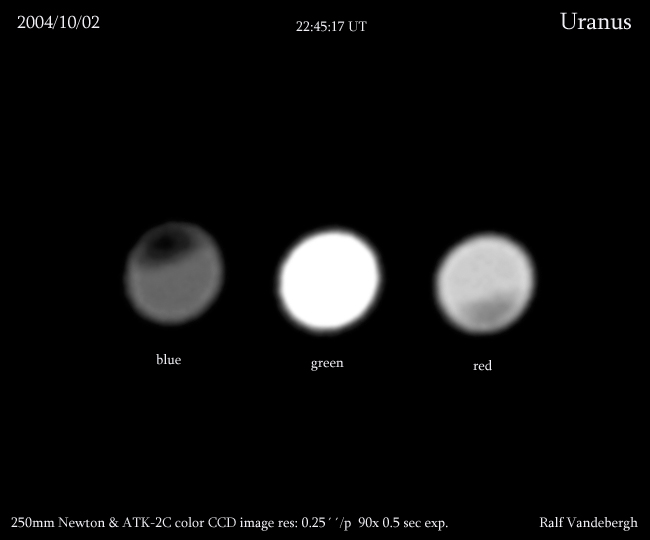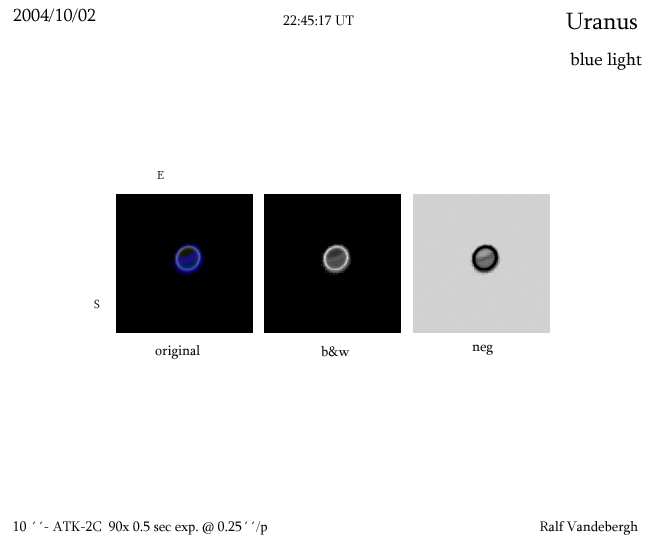天王星 月惑星研究会 関西支部
ALPO-Japan
Uranus Image 2004/10/02(UT)
Ralf Vandebergh
R.Vandebergh
|
Ralf Vandebergh(250mm Newton:ATK-2C)
|

These are my latest Uranus images again after a longer period of cloudy weather,at the same time I have improved my technique.
Both images are taken about 17 minutes after each other and show the same albedo feature together with the reknown polar flattening.
My image from Aug 12 show a simular feature.I used a practical resolution of 0,25 ´´/pixel and exposuretimes of 0,5 sec.
Ralf Vandebergh

Here are 2 additional contrast processings of the Oct 2nd Uranus image.

Hi ,
I finished working on a strong improvement of my observing and processing technique now,and the key might be
the good and full saturation of exposure,just what I already earlier thought.It seems to be necessary
to work in color because possible detail is dependent on soft color contrasts,though we can also try to
capture them on black&white CCD with the help of color filters if we have the arrangement of a large
telescope.In this image there is something like a zone visible bordered to the darker polar feature,which
was present already earlier im my black&white images.
The 'haze' around the disk of Uranus is due to atmospheric turbulance.
Also I have changed the orientation in my image; from now on my Uranus images will show the southpole
up,just like the other bright planets.

In the future I will show my images of Uranus not as one color image but
analysed in blue/green/red single images.Here is already one from October 2.
This will give better insight in my images and technique.
 In the red, Uranus has a bright band -- we can it a polar "collar" --
encircling the south pole. See our HST images. At blue, this collar's
contrast is reversed: it is a dark band. As the planet's sub-solar
point moves northward (i.e., we get closer to the "edge-on" equinox view
of 2007), this red-bright/blue-dark band makes the "polar" region
looks either bright (red) or dark (blue). Note that as Uranus turns more
edge-on, you will be seeing less of this band, and so the contrast of
that polar region will likely diminish over the next few years (it won't
look so bright in the red or so dark in the blue), and shift even further
poleward. You should expect to see this, so do not be surprised if
it happens. This is just due to viewing geometry changes.
Hi all,
This part of the message above from Heidi B Hammel, seems to be the resolution
of the problem I had with my blue light images, the south polar region
shows dark in in alle the images I took in the blue light.
Attached is an unprocessed raw image in the blue light taken on oct 2,
which shows that effect of the dark spc .
I have attached a more completed picture of my oct 2 Uranus image,with additionally
a negative version,which shows Uranus like we would see it in red/infrared.
The blue light image shows the South Polar Region dark,thus reversed to an image
taken in the red/infrared light.The lefter image is fully unprocessed,and shows the
original stack.
Also,the celestial orientation is on the image now.
[バンディバ:オランダ]
[Ralf Vandebergh:neighbourhood of Maastricht Netherlands]
In the red, Uranus has a bright band -- we can it a polar "collar" --
encircling the south pole. See our HST images. At blue, this collar's
contrast is reversed: it is a dark band. As the planet's sub-solar
point moves northward (i.e., we get closer to the "edge-on" equinox view
of 2007), this red-bright/blue-dark band makes the "polar" region
looks either bright (red) or dark (blue). Note that as Uranus turns more
edge-on, you will be seeing less of this band, and so the contrast of
that polar region will likely diminish over the next few years (it won't
look so bright in the red or so dark in the blue), and shift even further
poleward. You should expect to see this, so do not be surprised if
it happens. This is just due to viewing geometry changes.
Hi all,
This part of the message above from Heidi B Hammel, seems to be the resolution
of the problem I had with my blue light images, the south polar region
shows dark in in alle the images I took in the blue light.
Attached is an unprocessed raw image in the blue light taken on oct 2,
which shows that effect of the dark spc .
I have attached a more completed picture of my oct 2 Uranus image,with additionally
a negative version,which shows Uranus like we would see it in red/infrared.
The blue light image shows the South Polar Region dark,thus reversed to an image
taken in the red/infrared light.The lefter image is fully unprocessed,and shows the
original stack.
Also,the celestial orientation is on the image now.
[バンディバ:オランダ]
[Ralf Vandebergh:neighbourhood of Maastricht Netherlands]
 In the red, Uranus has a bright band -- we can it a polar "collar" --
encircling the south pole. See our HST images. At blue, this collar's
contrast is reversed: it is a dark band. As the planet's sub-solar
point moves northward (i.e., we get closer to the "edge-on" equinox view
of 2007), this red-bright/blue-dark band makes the "polar" region
looks either bright (red) or dark (blue). Note that as Uranus turns more
edge-on, you will be seeing less of this band, and so the contrast of
that polar region will likely diminish over the next few years (it won't
look so bright in the red or so dark in the blue), and shift even further
poleward. You should expect to see this, so do not be surprised if
it happens. This is just due to viewing geometry changes.
Hi all,
This part of the message above from Heidi B Hammel, seems to be the resolution
of the problem I had with my blue light images, the south polar region
shows dark in in alle the images I took in the blue light.
Attached is an unprocessed raw image in the blue light taken on oct 2,
which shows that effect of the dark spc .
I have attached a more completed picture of my oct 2 Uranus image,with additionally
a negative version,which shows Uranus like we would see it in red/infrared.
The blue light image shows the South Polar Region dark,thus reversed to an image
taken in the red/infrared light.The lefter image is fully unprocessed,and shows the
original stack.
Also,the celestial orientation is on the image now.
[バンディバ:オランダ]
[Ralf Vandebergh:neighbourhood of Maastricht Netherlands]
In the red, Uranus has a bright band -- we can it a polar "collar" --
encircling the south pole. See our HST images. At blue, this collar's
contrast is reversed: it is a dark band. As the planet's sub-solar
point moves northward (i.e., we get closer to the "edge-on" equinox view
of 2007), this red-bright/blue-dark band makes the "polar" region
looks either bright (red) or dark (blue). Note that as Uranus turns more
edge-on, you will be seeing less of this band, and so the contrast of
that polar region will likely diminish over the next few years (it won't
look so bright in the red or so dark in the blue), and shift even further
poleward. You should expect to see this, so do not be surprised if
it happens. This is just due to viewing geometry changes.
Hi all,
This part of the message above from Heidi B Hammel, seems to be the resolution
of the problem I had with my blue light images, the south polar region
shows dark in in alle the images I took in the blue light.
Attached is an unprocessed raw image in the blue light taken on oct 2,
which shows that effect of the dark spc .
I have attached a more completed picture of my oct 2 Uranus image,with additionally
a negative version,which shows Uranus like we would see it in red/infrared.
The blue light image shows the South Polar Region dark,thus reversed to an image
taken in the red/infrared light.The lefter image is fully unprocessed,and shows the
original stack.
Also,the celestial orientation is on the image now.
[バンディバ:オランダ]
[Ralf Vandebergh:neighbourhood of Maastricht Netherlands]



 ALPO-Japan Latest
ALPO-Japan Latest